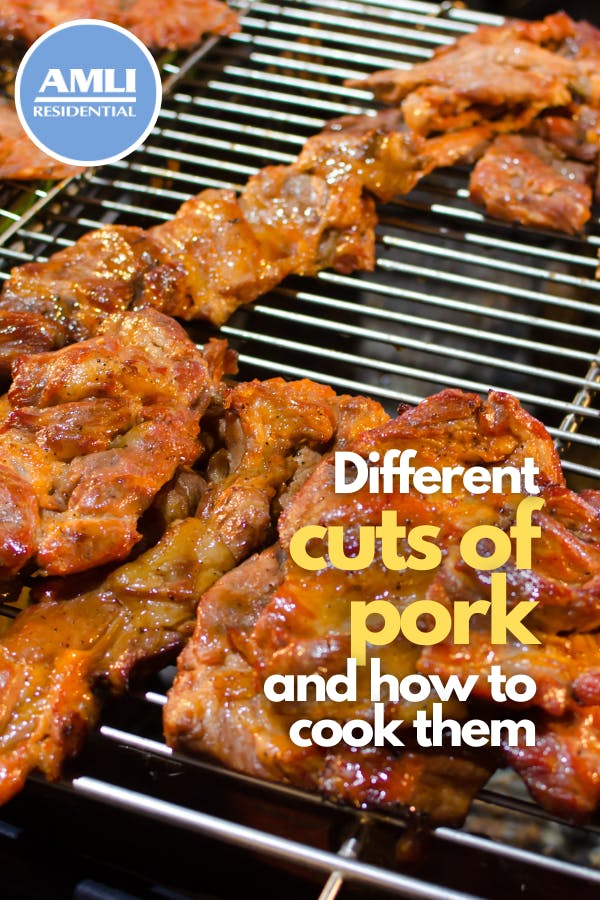No two cuts of meat are the same, and knowing each piece’s strengths and weaknesses are key to cooking the ideal steak, roast, sirloin or rack of ribs.
Cuts of meat can also get pretty confusing, too, and there are plenty of rabbit holes you can go down when looking to learn more about butchery.
At its core, though, pork can be categorized into primal cuts and subprimal cuts. Primal cuts refer to the large sections of meat that are cut first, after which smaller (subprimal) cuts are made.
Depending on your butcher and even your location, you may or may not see all the subprimal cuts offered at your local meat market. If you want specific cuts you can always ask your butcher directly, otherwise most meat sections at your local grocery store will have a small-but-decent selection to choose from.
Here are a few of the popular cuts of pork you’re most likely to see and, of course, how you can cook them to bring out the best in their flavor and texture!
How to prepare and cook different pieces of pork
Pork leg cuts
Taken from the hind leg and rump, this primal cut is often referred-to as the ham as well as the leg — but don’t confuse that with the picnic ham subprimal cut from the arm-shoulder! Like we said, it gets confusing.
Common pork leg/ham subprimal cuts you’ll see are:
- Ham: This iconic cut, derived mainly from the leg butt and sirloin tip, is typically cured and smoked to create the familiar savory flavor. However, fresh ham (essentially unprocessed pork leg) is also available.
- Shank: Located at the lower end of the leg, the shank is known for its rich flavor and abundance of connective tissue. This cut excels in slow-cooking methods like braising, stewing or making flavorful broths.
- Hock: Situated just above the foot, the hock is a smaller, bone-in cut packed with collagen. Similar to the shank, it's ideal for adding depth and richness to broths, soups and stews.
- Top loin: Nestled beneath the ham, the top loin is a long, tender muscle prized for its versatility. It can be roasted whole, sliced into chops or medallions for quick grilling or pan-frying or even ground for sausage!
- Sirloin tip: This triangular-shaped piece at the end of the top loin is leaner than its neighbor but still delivers good flavor. While sometimes sold as roasts or steaks, it's commonly used for grinding or stir-frying due to its quick-cooking nature.
- Inside round: Considered the most tender and flavorful muscle within the leg, the inside round is often sold as a whole roast or cut into tender steaks or medallions for quick preparation.
- Outside round: Slightly larger and less tender than the inside round, the outside round boasts a robust flavor and is suitable for grinding or creating thin cuts like schnitzel or cutlets.
- Knuckle: Also known as the leg tip, the knuckle is a lean cut with a significant amount of connective tissue. Due to its slow-cooking properties, it's well-suited for braising, grinding or adding richness to broths.
Pork loin cuts
The pork loin primal cut encompasses the upper-middle section of the hog; the lower-middle is referred to as the belly, which we’ll get into later.
Cuts from here are tender, tasty and prized among chefs and cooks for their delicate, lean pieces. They’re usually a little pricier than other cuts, but they’re well worth it!
- Center cut pork loin: This popular cut originates from the heart of the loin and boasts exceptional tenderness. It's typically sold bone-in as roasts or boneless as chops, ideal for grilling, pan-frying or baking.
- Blade loin: Situated near the shoulder end of the loin, the blade loin is slightly less tender than the center cut but still delivers good flavor. It's often sold as roasts or steaks and benefits from braising or slow cooking due to its connective tissue content.
- Tenderloin: Often referred to as the "filet mignon" of pork, the tenderloin is an incredibly tender, narrow muscle nestled inside the loin. It's typically sold whole and can be roasted, grilled or quickly pan-fried.
- Sirloin: Located at the tail end of the loin, the sirloin is a flavorful cut with more marbling than the center cut. It's commonly sold as roasts or steaks and can be grilled, pan-fried or even used for making ultra-flavorful ground pork.
- Rib loin: This cut incorporates the loin muscle and a portion of the ribs, offering both meat and bone for added flavor. It's typically sold as bone-in roasts and is well-suited for slow-cooking methods like roasting or braising.
- Loin filets: These are thin, boneless strips of meat cut from various parts of the loin, typically the center cut or sirloin. They're perfect for quick cooking methods like stir-frying or pan-frying or for making schnitzel.
Pork shoulder cuts
The pork shoulder is the front portion of the hog between the loin and the head, plus the entire front legs.
The meat from this section varies greatly and offers cooks plenty of choice in taste and texture. Parts of this section are highly fatty and, as such, often used to make ground pork and sausage. It’s also got some tough, muscly pieces that are best slow-cooked to make pulled pork or barbeque.
Common cuts of pork from the shoulder sections include:
- Boston butt (shoulder blade): This popular cut, also known as the pork butt or shoulder roast, originates from the upper portion of the shoulder. Despite the name "butt," it doesn't come from the animal's rear. This cut is well-marbled and benefits from slow-cooking methods like braising, roasting or smoking, resulting in tender and flavorful pulled pork or delicious roasts.
- Picnic shoulder (arm roast): Located beneath the Boston butt, the picnic shoulder (also known as the arm roast) is a leaner cut with more connective tissue. It's suitable for slow-cooking methods similar to those used for the Boston butt and can also be used for making ground pork.
- Shoulder blade steaks: These thin steaks, cut from the shoulder blade, are known for their intense flavor. They're typically marinated or braised due to their leanness and can be a budget-friendly option for grilling or pan-frying.
- Riblets: These small, bone-in pieces of meat come from the rib section of the shoulder. They're popular for grilling or smoking, offering a delicious combination of meat and cartilage.
- Jowl: The jowl, also known as the cheek meat, is a fatty cut located near the head section of the shoulder. It's often cured and smoked to create delicacies like guanciale (Italian cured pork cheek) or used for making ground pork due to its rich flavor.
- Hock: Similar to the leg hock, the pork shoulder hock is a smaller, bone-in cut with abundant connective tissue. It adds richness and depth to broths, soups and stews due to its slow-cooking nature.
- Neck bones: These bony pieces located at the top of the shoulder are often sold with some meat attached. They're primarily used for adding flavor to broths, soups and stews due to their high collagen content.
Pork belly/side cuts
The pork belly (also called the pork side) comprises the lower half of the middle sedition of pork below the pork loin. This section is fatty and rich, and because of its uniformity across the cut it’s not actually divided into subprimal cuts like the other portions! Rather, it’s cut into two popular fan-favorite pieces: bacon and spareribs.
- Bacon: American bacon comes from the belly, while other countries typically take bacon from the back up by the loin. Belly bacon is streaky and varies in fattiness, depending on how you cut it, so it’s best cooked fried in order to properly render the fat.
- Spareribs: This cut features much of the same kind of meat as bacon, but interspersed with some ribs taken from the lower part of the ribcage. They’re not as thick and meaty as baby-back ribs taken from the loin, but they’re fatty, flavorful and great when roasted or smoked.
Whether you’re cooking ribs in the smoker, frying up some morning bacon or experimenting with some pork medallions, knowing what cut works with what cooking method will change your cooking game for the better! Get to know your local butcher and you may find that you have access to even more unique cuts than the ones listed here — from there, the sky’s the limit!
Enjoy!
Pin it!

Featured photo by Luis Aleman on Unsplash


 View All Posts by Colleen Ford
View All Posts by Colleen Ford